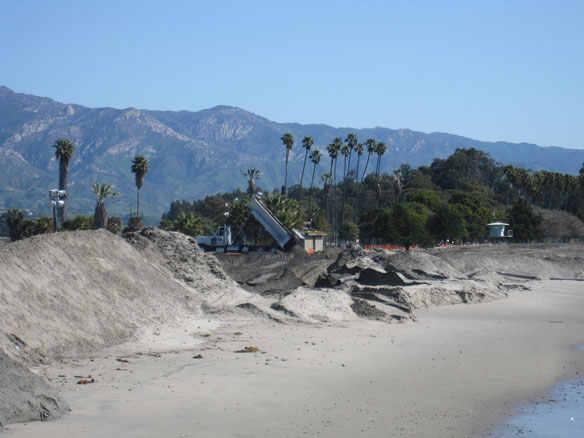
Beach re-nourishment, California. Photo source: © SAF — Coastal Care
“Beach nourishment projects have become commonplace along the US East and Gulf Coasts. These projects have immediate environmental impacts through burial of nearshore habitat and increased turbidity during project placement.The cumulative environmental impacts of doing this repeatedly on the same beach while conducting projects from Maine to Texas is unknown. But, we should be concerned. ” —Robert S. Young, PhD, Director, Program for the Study of Developed Shorelines, Professor, Coastal Geology, Western Carolina University
Excerpts;
Utilizing the Cornell University Long and Intermediate WAVE (COULWAVE) Boussinesq wave model, the effect of the construction of a conventional beach nourishment project in Surf City, New Jersey, on the quality of the local surf break is examined in detail. A 20-year-long nearshore synthetic wave record is first developed for use in creating a monthly wave climate “almanac” so that typical seasonal effects on surf-break quality can be objectively portrayed. The wave model is then run with preconstruction bathymetric conditions, and with three postconstruction surveys performed in subsequent months.
Construction of the nourishment project was found to affect the quality of the surf break adversely by (1) compression of the surf zone, (2) an increase in the occurrence of “closeouts,” (3) a shift in breaker type toward collapsing breakers, particularly during high tide, and (4) an increase in wave reflection—findings that are in agreement with anecdotal testimony offered by local surfers.
On the basis of modeling results conducted using the sequential postconstruction surveys and the wave almanac, it appears to have required nominally 21–22 months for the surf-break quality to return to preproject conditions. A paradigm shift in the design and construction of beach nourishment projects in the United States is required if such effects are to be avoided, and several options are offered and discussed…
Read Full Article, JCR (02-05-2018)
A wider, deeper beach awaits Ocean City vacationers, but is it safe? The Washington Post (06-01-2018)
Ocean City vacationers may notice deeper, wider beaches, the result of a $282 million sand-dredging project aimed at protecting the resort town from storm damage. But the work also raises concerns about surf injuries and swimmer safety…
Widening beaches might bring more hazards, researchers say; Sun Sentinel (04-04-2018)
Widening beaches might be linked to an increase in accidents, according to new data. The number of ocean rescues spikes after beaches are buffed up, according to the data published in the Journal of Ocean Research…
Why This Treacherous Hawaiian Beach, Keeps Breaking People’s Necks, The Washington Post (10-27-2015)
Adding new sand didn’t merely widen the beaches, they found — it made them higher, “resulting in steep slopes that can cause large waves to break close to shore. In other words, replenishment was doing to Delaware’s beaches what nature long ago did to Hawaii’s Sandy Beach…
Piling sand to stop erosion ultimately made the land sink, study says, NOLA (12-26-2015)
Coastal geologist criticizes beach renourishment efforts; By Robert S. Young, PhD; The State (08-17-2016)
Rob Young, who heads the Program for the Study of Developed Shorelines at Western Carolina University, said the government is subsidizing coastal development with renourishment money – and that’s costing taxpayers. Communities across the country have spent millions of dollars renourishing beaches. Those efforts encourage people to rebuild after every major hurricane…
Palm Beach Mid-Town Dredge Project, A Youtube Video (02-04-2015)
“Beach nourishment projects like this have become commonplace along the US East and Gulf Coasts. These projects have immediate environmental impacts through burial of nearshore habitat and increased turbidity during project placement.The cumulative environmental impacts of doing this repeatedly on the same beach while conducting projects from Maine to Texas is unknown. But, we should be concerned. ” —Robert S. Young, PhD, Director, Program for the Study of Developed Shorelines, Professor, Coastal Geology, Western Carolina University
Beach replenishment may have far reaching impacts on ecosystems;” Phys.Org (03-29-2016)
UC San Diego biologists who examined the biological impact of replenishing eroded beaches with offshore sand found that such beach replenishment efforts could have long-term negative impacts on coastal ecosystems…








